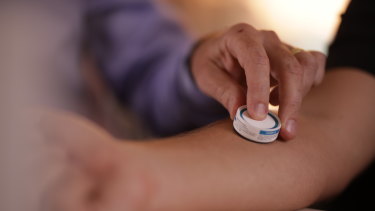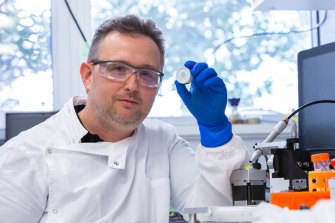A needle-free COVID-19 vaccination has passed pre-clinical trials, with its developers excited by the possibility of a painless, easy-to-use patch that could roll out in future waves of coronavirus vaccination.
Australian company Vaxxas, which was spun out of the University of Queensland to develop the technology, has been working with the University of Texas Hexapro vaccine candidate for the study.
UQ’s David Muller, who has been running the pre-clinical trials, said they had seen excellent results in their mouse models, even better than the results from the same vaccine administered via needle and syringe.
“The results so far have been amazing; we’ve been able to get a COVID-neutralising antibody response with a single dose in mice,” he said.
The patch has thousands of tiny “microprojections” or mini-needles on its surface that are coated in the vaccine.
Dr Muller said those delivered the vaccine to a specific layer of the skin that prompted a more immediate and robust immune response compared with traditional vaccinations.
“Because of that targeted delivery, we’re able to generate much stronger immune responses,” he said.
“The body responds to the mixture of very tiny damage signals and immune signals and the co-localisation in that layer of the skin attracts a lot of immune cells, so you get this very potent immune response.”
Unlike needles, the patches do not hurt, and, because they are single-use, there is no risk of cross-contamination.
Hexapro is a relatively stable vaccine, so the patches can be stored at room temperature, and have been tested and remain stable for at least 30 days at 25 degrees and one week at 40 degrees.
University of Sydney vaccine and infectious diseases expert Professor Robert Booy has championed the promise of the Vaxxas patch, and in the past few months made that official by joining Vaxxas as their medical director.
He said they were working on securing funding for clinical trials for the COVID vaccination using the patch, and so it would probably not be part of the first phase of vaccinations to protect against the pandemic.
However, he said it could be extremely useful in rapidly responding to variants that cropped up in the future.
“Because it doesn’t need the cold chain nearly as much as a needle and syringe, it could get out to the far jungles or mountains or archipelagos of any country in Asia or Africa,” he said.
“People can even administer the product to themselves, previous qualitative research has shown people can self-administer the patches with simple instructions.”
Professor Booy said Vaxxas had previously announced trials of the patch for rolling out flu, polio and measles vaccination.
“This is a platform technology that could help to deliver half a dozen different vaccines,” he said.
“Needle and syringe does a great job, we’ve saved literally hundreds of millions of lives in the last century through immunisation.
“But, given the rate at which people now travel, the rate at which forests are cut down, all the related factors, we’re only going to get more viruses transmitting to humans, and this could be the way we meet that challenge in the future.”
The pre-clinical trial data has not yet been published in a peer-reviewed journal but has been made available on the pre-print server bioRxiv.


No comments:
Post a Comment
Note: Only a member of this blog may post a comment.